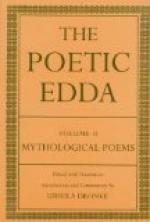Gudrun sent her three sons to avenge their sister; two of them slew Erp by the way, and were killed themselves in their attack on Joermunrek for want of his help. So died, as Snorri says, all who were of Giuking descent; and only Aslaug, daughter of Sigurd and Brynhild, survived. Heimskringla, a thirteenth century history of the royal races of Scandinavia, traces the descent of the Norse kings from her.
This Ermanric story, which belongs to legendary history rather than myth, is in reality quite independent of the Volsung or Nibelung cycle. The connection is loose and inartistic, the legend being probably linked to Gudrun’s name because she had become a favourite character and Icelandic narrators were unwilling to let her die. The historic Ermanric was conquered by the Huns in 374; the sixth century historian Jornandes is the earliest authority for the tradition that he was murdered by Sarus and Ammius in revenge for their sister’s death by wild horses. Saxo also tells the story, with greater similarity of names. It seems hardly necessary to assume, with many scholars, the existence of two heroes of the name Ermanric, an historic and a mythical one. A simpler explanation is that a legendary story became connected with the name of a real personage. The slaying of Erp introduces a common folk-tale incident, familiar in stories like the Golden Bird, told by both Asbjoernsen and Grimm.
* * * * *
Helgi.—The Helgi-lays, three in number, are the best of the heroic poems. Nominally they tell two stories, Helgi Hjoervardsson being sandwiched between the two poems of Helgi Hundingsbane; but essentially the stories are the same.
In Helyi Hjoervardsson, Helgi, son of Hjoervard and Sigrlinn, was dumb and nameless until a certain day when, while sitting on a howe, he saw a troop of nine Valkyries. The fairest, Svava, Eylimi’s daughter, named him, and bidding him avenge his grandfather on Hrodmar (a former wooer of Sigrlinn’s, and her father’s slayer), sent him to find a magic sword. Helgi slew Hrodmar and married Svava, having escaped from the sea-giantess Hrimgerd through the protection of his Valkyrie bride and the wit of a faithful servant. His brother Hedin, through the spells of a troll-wife, swore to wed Helgi’s bride. Repenting, he told his brother, who, dying in a fight with Hrodmar’s son, charged Svava to marry Hedin. A note by the collector adds “Helgi and Svava are said to have been born again.”
In Helgi Hundingsbane I., Helgi is the son of Sigmund and Borghild. He fought and slew Hunding, and afterwards met in battle Hunding’s sons at Logafell, where the Valkyrie Sigrun, Hoegni’s daughter, protected him, and challenged him to fight Hoedbrodd to whom her father had plighted her. She protected his ships in the storm which overtook them as they sailed to meet Hoedbrodd, and watched over him in the battle, in which he slew his rival and was greeted as victor by Sigrun: “Hail, hero of Yngvi’s race ... thou shalt have both the red rings and the mighty maid: thine are Hoegni’s daughter and Hringstad, the victory and the land.”




